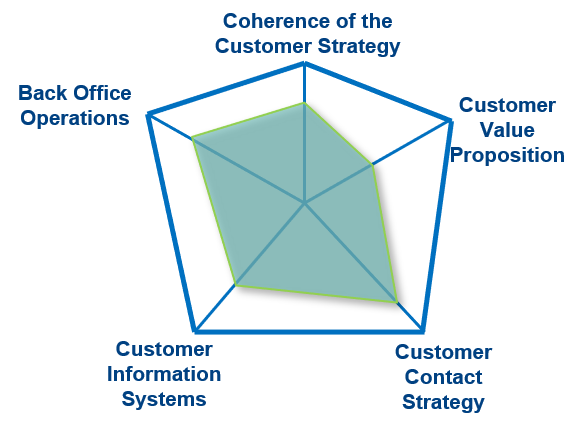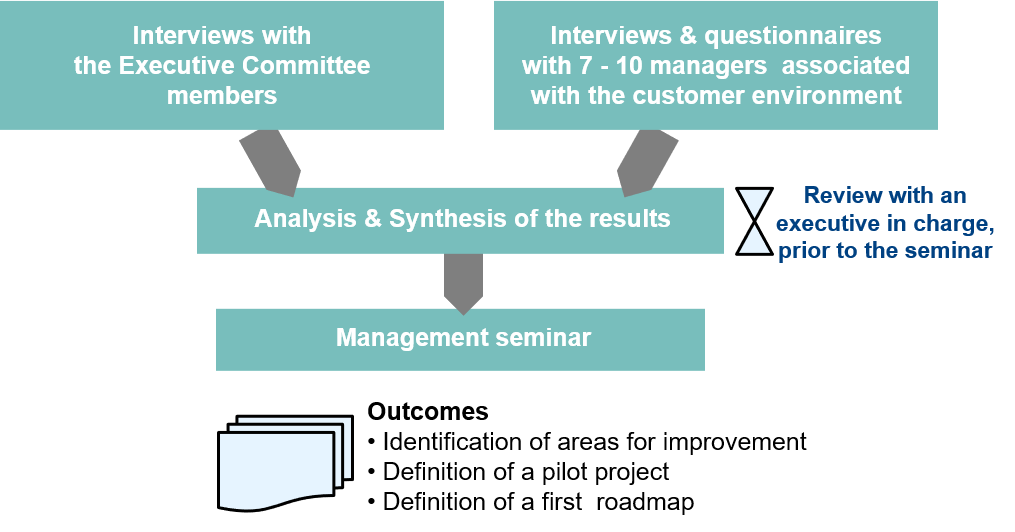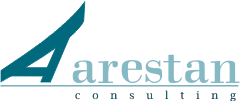Looking ahead to 2021-22, this may be the time to undertake a quick and targeted diagnosis of your company’s customer strategy and approach.
Even if you are happy with your approach, or you already have an organizational project underway, the implementation of a rapid evaluation tool for your firm’s position on customer dimensions would be a plus to evaluate and eventually adjust the road to the defined target.
In this note, we propose a framework using 5 environments that are critical to a successful customer strategy. We first describe the environments and define the basic questions that need evaluation or answers. We then propose a non-intrusive approach which, in a short period, will allow your organization to:
- Identify the areas of improvement;
- Target the areas, and the efforts for improvement; and
- Provide an evaluation tool to measure the company ’s progression towards a « desired » and not an « imposed » position.
A) 5 Environments critical to a successful customer strategy

Our view of the 5 critical environments for a successful customer strategy is depicted in the diagram. For each of these environments, we have identified a set of key elements that the company and its personnel, especially the managers and those who deal with customers, need to converge on, otherwise risks are high for customer disillusion.
i) Coherence of the customer strategy
- Understanding customer segments: Do all interested parties know and agree on the differentiating characteristics of clients?
- Agreement on the notion of value: Does everybody understand the same things when we speak of value generated by a customer?
- Existence of strategies adapted to each segment: Does everybody agree that strategies vary according to customer segments?
- Follow-up on and adaptation of strategies: And finally, do we follow the results of these strategies and do we adapt them if they are not satisfactory?
ii) Customer value proposition
- Consideration of customer needs: Do the offers correspond to customer needs?
- Consideration of segments’ objectives: Is our offer strategy compatible with our objectives for each segment?
- Offer development processes: Do we have offer creation processes that combine creativity, analytical rigor and the « voice of the customer »?
iii) Customer contact strategy
- Strategic management of channels: Do we manage our contact channels (direct/indirect salesforce, telemarketing, internet, …) strategically?
- Customer information flow: Are customer information shared between channels fluidly?
- Strategic follow-up on channel performance: Have we implemented channel performance measuring systems?
iv) Customer information systems
- Collection and relevance of data: Are the contents and the frequency of data collection in line with our business? Is the data reliable?
- Extraction and modeling of data (Strategic Information): Are the data extraction and modeling systems designed to generate useful (strategic) information?
v) Back-office operations
- Integration of customer characteristics in the workflow: Have we integrated customer segment characteristics in our back-office processes and workflow?
- Availability of customer information to back-office: Are customer information available to these services?
- Continuous improvement programs: Do we have continuous improvement programs?
The elements identified above will be addressed through a questionnaire. Most of the questions will be closed quantitative evaluations (scales 1-4 or 1-6) with a few open qualitative evaluations. They will be administered during the interview sessions and analyzed for discussions during a management seminar (see the next section: “Proposed approach to diagnose your customer strategy quickly”).
B) Proposed approach to diagnose your customer strategy quickly
Armed with the above framework and the set of questionnaires, we can proceed to an approach that is quick, efficient and non-intrusive. The objective being to not destabilize the company’s operations and state of mind.
The diagnostic should identify the firm ’s current state and the areas for improvement, through an objective evaluation complemented by a series of quantifiable indicators.
Proposed approach to produce a quick, efficient and non-intrusive diagnosis of an organization’s customer strategy

The process should mobilize the executives and a part of the company’s management, to enable them to build a common vision. However, to be constructive, this exchange should be based on prepared and validated elements.
This approach is based on an internal diagnostic, because the internal vision of the situation has a direct impact on the motivation of the personnel. Nevertheless, the approach and the data analysis model allow us to check the coherence of the views and identify the eventual areas where an external investigation would be necessary.
Furthermore, the simplicity and efficiency of the approach could make it into a recurrent exercise every 15 – 18 months, as part of a continuous improvement of the company’s customer strategy.
One last note: we strongly recommend to use external experienced consultants to plan, design and implement the approach for 2 reasons:
- The participants (executives and managers) are more open to discussing their full views with external experienced consultants than with internal personnel; and
- An experienced external consultant is more prepared to challenge the participants during the interviews and the seminar to go beyond easy and readymade answers, whereas internal personnel may be more reticent to do so, either because of discomfort due to relative hierarchical positions or being biased by a shared view of and adherence to the same readymade answers.
Hooman Darabian
Director Arestan Consulting & Partner Jazz Conseil
with Philippe Chidaine, Pierre Menant, Olivier Pescia, Partners Jazz Conseil



Leave a Reply